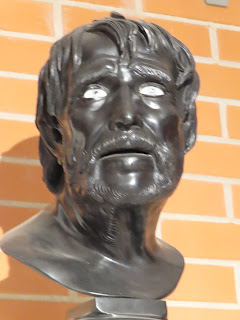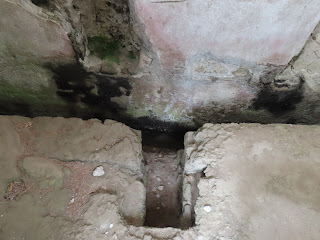Herculaneum was destroyed by very hot pyroclastic flows. Estimates of how hot these temperatures were range from 500 degrees to 1000 degrees Fahrenheit. It resulted in instant death for the residents. Ironically for the wooden structures, the wood did not burn but was carbonized by the high heat and the lack of oxygen. So the wooden door jams are still intact but they are now charcoal instead of wood. This presented problems for early archeologists as the carbonized wood could no longer support the walls they originally supported. So the walls required additional external support as the excavations continued. The history of the re-discovery of Herculaneum began with the digging of a well. The farmer digging the well found marble pieces which is a rare stone for these parts. So the Spanish Bourbon's got wind of this and they bought the well. Then they started tunneling through the ruins, much damage was done, they got lucky in some areas but it eventually proved too inefficient to just tunnel about. A few centuries later they decided to dig the city out from under all the rock and ash.
A suspended walkway takes us over to the town
The sea used to reach these boat houses
Dogs are allowed
Our first courtyard
No expense was spared in the column department
All the homes followed the same basic floor plan, atrium, courtyard, private rooms and some sort of a shrine
The shrines varied in size and detail
Each house was richly decorated with frescos
The artistry was evident in each surviving fresco
The fast food joints of the day. Fires were lit under the holes and food was cooked to be served hot
This alluvium was very ornate
Remnants of the roof are still visible which explains how these frescos survived
The floors were also detailed
The paintings of windows on either side must have given the impression of more space
This was the meeting house for the freed men, the house of Augustales. These newly freed men were trying to enter into the local society and had to prove their worth
The motto of the club
The main support beams are still in place
The floors were made with broken pottery bits
A slave occupied this room by the door and acted like a gatekeeper
The courtyard
These frescos really make the room special
Two stories
Mosaics on the floor
The colors are vivid
Another food stall area
Every inch is painted
A hallway into another house
Adorned with fine statues
No need to step on the dog!
This is the edge of the excavations. Above is the town that was built on top of the ruins. Only 25% of Herculaneum had been evacuated and the existence of the town means it will probable stay that way.
Painted archway
Each house is very linear, hallways lead through the entire house
Black mosaics
We are entering the atrium of the baths
This honeycomb arrangement of the bricks is more earthquake resisten
A kitchen area
An open are was the gymnasium
The visitors could work out
Once the work up a sweat they go into the baths
first the tepidarium, medium heat
Stalls for storing possessions
A skylight
A basin for preliminary rinsing
A nautical mosaic design
The walls are corrugated to channel the moisture down the walls instead of it dripping on the patrons
Into the next room
Behind this rounded wall was the hottest bath
Into another house with decorative downspouts
This one was very well preserved
Parts of a bed
A fancy alluvium to collect the rainwater and send it to the cisterns
Love the floor
The second story was decorated with mock columns and railings
A great look
My favorite cow
In the floor
On the walls
Blue on the top and draperies painted on the bottom
A public fountain
Heading to the edge of the excavations
An oven
A grist mill for grinding the grain
Ovens and jars
Another oven, maybe for cooking flat bread on the side of the jar
Large frescos nearly intact
Nice arched area
Toilets
Two stories!
Flooring
When there was a nicer bit of painting on the wall they put up a frame to protect it
A well preserved corner
This was one of the nicesy villas
Very large and with a view of the sea
Produce in abundance
Fruit anyone?
Most of the rooms had surviving frescos
Carry a big stick and pee wherever you want to
This was the front entrance
Great design
The last house on this level. The house of the Relief of Telephus
The columns still have the plaster overcoat
Hey there!
This is the relief of Telephus
The houses closer to the water were larger
Looking down to the lower level
A large marble proclaiming the great deeds of Marcus Nonius Balbus. Notice the ramp behind, it was quite steep and uneven
Marcus Nonius Balbus himself
This statue seems the be half original and half crudely reconstructed
This area seemed to be more commercial, large storehouses and warehouses
Less decorated
Back up and on our way out
A press of some sort, perhaps the laundry
The jar is not a door
Part of the drainage and water catchment system
Where might this archway led too? Deep under the existing town
These areas are only partyl excavated
The women and children were trapped in the boatsheds
Over 300 have been found
No time to escape
One last display of a Roman boat. This is the rudder
Sheathed in copper on the bottom
The planks and ribs remain
This boat was in one of the baths and was being repaired
Very well preserved
One seriously bumpy taxi ride back to the train station
This is how folks are supposed to cross the train tracks
It doesn't work when the train has already arrived. The man in a yellow shirt ran to get around the train
Despite waving at the engineer, he missed the train
Cat on the hot train track
It has been 2 years and 333 days since we began our Migration














































































































